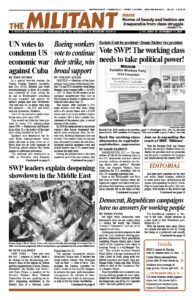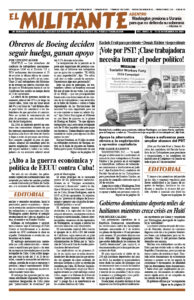The BRICS alliance, led by Beijing and Moscow to counter Washington, held its annual summit Oct. 22-24, hosted by Russian President Vladimir Putin. Behind its veneer of unanimity, the conference highlighted the divergent interests within the bloc, tensions over Moscow’s invasion of Ukraine, and worldwide economic uncertainty and rising military conflicts.
The summit was held in Kazan, the capital of the Russian republic of Tatarstan, and drew representatives from 36 governments. Putin hoped to use the largest gathering of government heads in Russia since his forces invaded Ukraine to highlight the difficulties Washington and its allies have had isolating his regime.
In recent years Moscow and Beijing expanded BRICS, whose initials reflect the founding governments — Brazil, Russia, India, China and South Africa. It now includes the governments of United Arab Emirates, Iran, Egypt and Ethiopia. At the end of last year, the new Argentinian government pulled back from joining, as did the rulers of Saudi Arabia.
Like every other multinational bloc across the capitalist world, the BRICS alliance is riven by competing national interests. Moscow and Beijing try to harness it to advance their challenges to Washington’s world economic and political supremacy and to seek more trade and investment opportunities. But other BRICS governments are more aligned with Washington or try to balance between it and Moscow and Beijing.
World capitalist crisis deepens
Nations whose governments are in BRICS now account for over half the earth’s population and a third of its economic output, with China predominating. The grouping aims to rival the G7, a club of the seven largest imperialist powers, Canada, France, Germany, Italy, Japan, the U.K. and the U.S.
More than 30 other nations from North Africa to the Mideast and Latin America to Southeast Asia have asked to join BRICS. They all hope to gain economic and political advantage against their rivals as the world capitalist crisis deepens.
The sheer economic size and increasingly assertive foreign and trade policy of China’s rulers have given them a dominant influence in BRICS. Many countries asking to join have a heavy trade and debt dependence on Beijing.
Amid its worst financial crisis in decades, the government of Sri Lanka, with over half its foreign debt of almost $50 billion owed to Beijing, has applied to join BRICS. In 2017, the island’s rulers were forced to turn over the port of Hambantota to Beijing to get part of their debt cancelled.
Putin’s proposal to invite the government of Venezuela to join was vetoed by the Brazilian government. Brazil’s president, Luiz Inácio Lula da Silva, doesn’t accept the result of July’s election in which Venezuelan President Nicolás Maduro claimed a narrow win.
Just before the summit, the governments of India and China reached a deal to defuse tensions on their Himalayan border after deadly clashes between their troops took place there four years ago. Indian Prime Minister Narendra Modi met formally in Kazan with China’s President Xi Jinping for the first time in five years.
The rulers of the two nations remain rivals for influence in their region. Beijing is a close ally of the rulers of neighboring Pakistan, who are in conflict with the Indian government. New Delhi is trying to offset Beijing’s growing economic and military weight. At the same time it is in BRICS, the Indian government is part of the Quad grouping with the imperialist rulers of the U.S., Japan and Australia.
The final statement from the summit condemned U.S.-led trade and financial sanctions against Russia, which fall hardest on working people there. The governments of China and India are buying Moscow’s oil at a heavily discounted rate, a crucial lifeline for Putin. But the summit gave no backing to the Putin regime’s invasion of Ukraine.
Putin led the push for BRICS governments to reduce their reliance on the U.S. dollar as a global currency. While bilateral trade in national currencies is increasing, this hasn’t shaken the dollar’s world dominance.
Putin hoped to use the summit to showcase Moscow’s role in the world, but in reality its power has been diminished as a result of his regime’s long draining attempt to conquer Ukraine.
Putin desperate for recruits
Across the Russian Federation, Moscow’s recruitment and arms production can’t keep up with heavy losses by its army. Men and armor are being depleted in suicidal attacks to try to wear down Ukrainian defenses.
Putin’s forces have had difficulty dislodging Ukrainian forces from hundreds of square miles of Russia’s Kursk territory they hold at the same time that Moscow is pursuing its offensive in Ukraine’s east.
Several thousand North Korean soldiers are reported to have been sent to Russia, possibly to be used in its western Kursk region. Putin signed a mutual defense treaty with North Korean leader Kim Jong Un in Pyongyang in June.
The Ukrainian government launched a new Korean-language video Oct. 23 as part of its project “I Want to Live.” It calls on North Korean soldiers entering the war to surrender to Ukrainian forces. It says, “You must not die senselessly in a foreign land. You must not repeat the fate of hundreds of thousands of Russian soldiers who will never return home!”
In the statement, North Korean troops are guaranteed safe conditions of detention, food, and medical care by the Ukrainian side. It is unclear whether the North Korean troops are involved in any combat.

